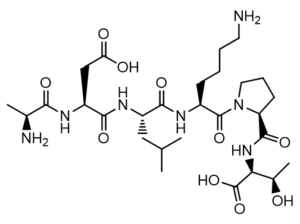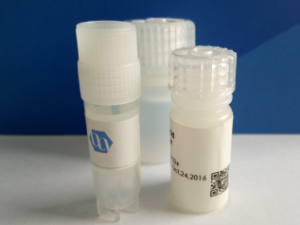$ 500.0
Quantity: 50 MG
Available on backorder
Description

Product name: Peptide Vinci 02
Catalog#: 1801101
Synonyms: ADLKPT,Fibronectin-like peptide,
CAS NO.:
Sequence: Ala-Asp-Leu-Lys-Pro-Thr
M.W: 643.73
M.F.: C28H49N7O10
Purity: 95% by HPLC
Counter ion: Trifluoacetate
Format: Lyophilized powder
Description: The hexapeptide with the sequence ALA-ASP-LEU-LYS-PRO-THR represents a group of biomimetic fibronectin peptides, and it is created in order to mimic fibronectin, a protein present in the extracellular matrix. This protein, which is synthesized by fibroblasts and keratinocytes, is involved in many biological processes, including tissue repair and cell migration such as in embryonic migratory pathways and in the provisional matrix of healing wounds and cell adhesion (Yamada 2000). The good adhesion is linked with an appropriate three-dimensional organization of cutaneous tissue that is connected with healthy and young skin. It is thought that increasing fibronectin levels help to improve the appearance of aging skin. Fibronectin is crucial for the maintenance of skin integrity and important for skin repair, its level is increased during wound healing process. However, it was found that UV radiation increases its degradation in skin. Furthermore, fibronectin was found at decreased levels in the papillary dermis of aging skin (Ptchelintser, Avon Products Inc., US Pat. No. 2009/0082252; Ray et al. 2006; Labat-Robert et al. 2000). Due to the size of fibronectin, its effectiveness at the cutaneous level is limited. Therefore the hexapeptide (ALA-ASP-LEU-LYS-PRO-THR) is created to play the role of a homolog of a 6-amino acid sequence present in the type III unit of the fibronectin molecule and thus can mimic the activities of above-mentioned protein. This peptide stimulates an extracellular matrix protein synthesis in vivo, promotes the adhesion between skin cells in order to provide curative or preventive treatment of ageing skin symptoms and thus improves skin appearance (Dal Farra, Domloge, US Pat. No. 2004/0141939). The application of this hexapeptide on cultured keratinocytes reinforces cell adhesion. Moreover, the hexapeptide has the ability to increase integrin expression and provide a signal for skin repair. The preferred concentration range of the peptide with the sequence ALA-ASP-LEU-LYS-PRO-THR in a cosmetic composition is between 0.5 and 3.0 % by weight (Denommee, US Pat. No. 2007/0237735). The potential anti-age effects of a synthetic fibronectin-like peptide was investigated in two double blind studies. A detailed questionnaire given to volunteers and clinical studies of treated areas enabled to assess the effects of active ingredient. In the first study twelve volunteers applied the cream containing the fibronectin-like peptide twice a day on the back of one hand and the placebo on the other hand. A lightening effect and increased smoothness of skin was observed after 1 h, 3 h and after 7 days. In the second study one group of volunteers applied cream containing the active ingredient on the lips, and the other group applied placebo. A significant improvement of skin hydration (155.56 % at 3 h) and smoothness (425.01 % at 1 h and 533.33 % at 3 h) was observed. Therefore the researchers suggest that the fibronectin-like peptide can be of great use in anti-aging skin care products (Farra et al. 2007). The synthetic peptide was developed by Vincience and is commercially known as Vinci 02. The company carried out and extensive research on the effects of this compound and they concluded that Peptide Vinci 02 was highly stable and had a high fibronectin-like effect on cell adhesion, cell differentiation (Cosmetics and Toiletries 2006).
Uniprot ID:
Usage: For Scientific Research Use Only, Not for Human Use.

